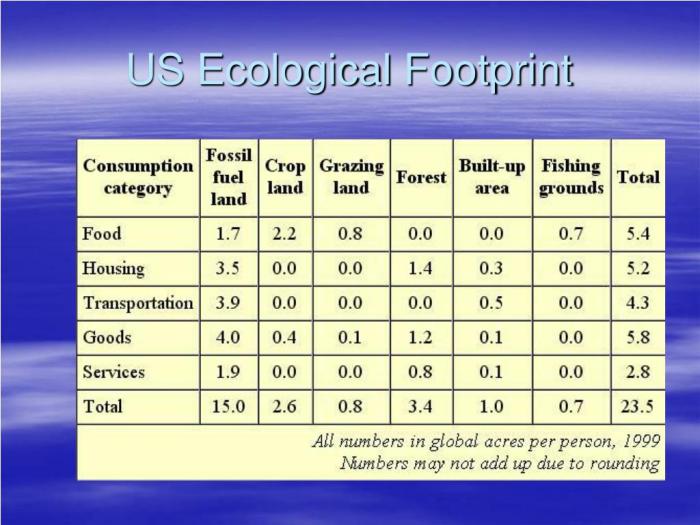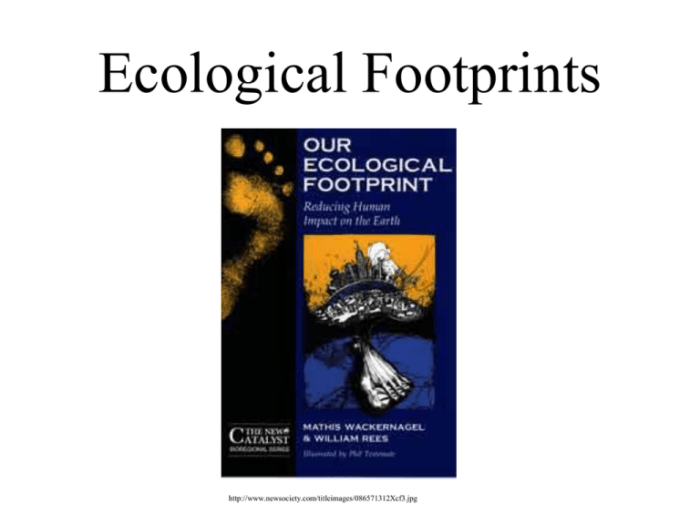Analyzing ecological footprints reveals that they provide crucial insights into the environmental impact of human activities. By assessing the ecological footprint of a region or individual, we gain valuable information about the demand placed on natural resources and the implications for sustainability.
Ecological footprint analysis serves as a comprehensive tool for understanding the relationship between human consumption and the carrying capacity of the planet. It enables policymakers, businesses, and individuals to make informed decisions that promote environmental conservation and sustainable development.
Measuring Ecological Footprints

Calculating ecological footprints involves quantifying the amount of land and water required to sustain a population or individual. The Ecological Footprint Accounting (EFA) method is commonly used, which considers six land use categories: cropland, grazing land, forest land, fishing grounds, built-up land, and carbon footprint from fossil fuel use.
Indicators and Metrics
- Biocapacity:The amount of biologically productive land and water available within a defined area.
- Ecological Footprint:The total area of land and water required to produce the resources consumed and absorb the waste generated by a population.
- Ecological Deficit:Occurs when the ecological footprint exceeds the biocapacity, indicating unsustainable resource consumption.
- Ecological Reserve:Occurs when the biocapacity exceeds the ecological footprint, indicating sustainable resource use.
Tools and Frameworks
- Global Footprint Network: Provides online tools and data for calculating ecological footprints.
- National Footprint Accounts: Country-level ecological footprint assessments conducted by partner organizations.
- Redefining Progress: Develops and promotes alternative economic indicators, including ecological footprint.
Factors Influencing Ecological Footprints

Ecological footprints are influenced by a multitude of factors, including:
Population Growth
- Increasing population leads to higher resource consumption and waste generation.
- Rapid population growth can strain natural resources and contribute to ecological deficits.
Consumption Patterns, Analyzing ecological footprints reveals that
- High consumption of resource-intensive products (e.g., meat, fossil fuels) increases ecological footprints.
- Sustainable consumption practices, such as reducing meat consumption and using renewable energy, can reduce footprints.
Technological Advancements
- Technological advancements can improve resource efficiency and reduce waste.
- However, certain technologies (e.g., fossil fuel extraction) can also contribute to ecological footprints.
Global and Regional Variations in Ecological Footprints

Ecological footprints vary significantly across countries and regions. Factors contributing to these variations include:
Economic Development
- Developed countries typically have higher ecological footprints due to high consumption levels.
- Developing countries often have lower footprints due to lower consumption and more sustainable practices.
Population Density
- Areas with high population density have higher ecological footprints due to increased resource consumption and waste generation.
- Sparsely populated areas have lower footprints due to lower consumption and more available resources.
Resource Availability
- Countries with abundant natural resources (e.g., forests, water) have lower ecological footprints.
- Countries with limited resources have higher footprints due to the need to import resources from other regions.
User Queries: Analyzing Ecological Footprints Reveals That
What are the key factors that influence ecological footprints?
Population growth, consumption patterns, technological advancements, economic development, and resource availability are among the key factors that shape ecological footprints.
How can we reduce our ecological footprint?
Reducing consumption, adopting sustainable practices, investing in renewable energy, and promoting resource efficiency are effective strategies for reducing ecological footprints.